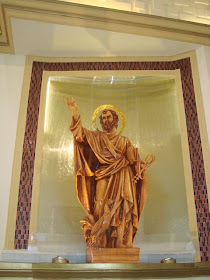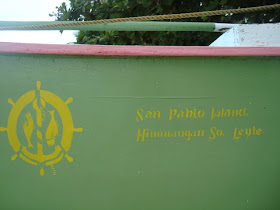The territory of the town of Hinunangan, S. Leyte includes two inhabited islands called San Pedro, (the bigger one) and San Pablo (just near the southern tip of San Pedro) named after the patron saints of the town. These two islands have beautiful white beaches made of sand and corals. Just about twenty minutes by boat from Brgy. Canipaan, the jump off point to the islands, San Pablo is an ideal place to unwind and hide for a well deserved rest.
Last July 13 and 14, while typhoon Basyang unexpectedly rammed through Metro Manila, together with my parochial vicars Frs. Bench and JV, Frs. Roy and Alcris, Ronnie and two others we went for a day off to San Pablo island for an overnight trip. The night before I called up the parish priest of Hinunangan, Fr. Cruf, who was my former student to contact for us a place to stay in San Pablo. Since he was in Cebu, he called his Vicar Fr. Joto to make reservations in San Pablo and prepare for our food.
After the Silago road has been opened just a few years back, travel to the pacific towns of S. Leyte has become a breeze. Whereas before it would take about five hours to reach the place, now with the new road from Abuyog, one can reach Hinunangan from Palo in a matter of two hours. Lunch was ready at the convento in Hinunangan when we arrived. I noticed that their church has been renovated. They have a new belfry and a beautiful altar. About four years ago, a strong earthquake badly damaged the belfry and cracks appeared in the church.
After the Silago road has been opened just a few years back, travel to the pacific towns of S. Leyte has become a breeze. Whereas before it would take about five hours to reach the place, now with the new road from Abuyog, one can reach Hinunangan from Palo in a matter of two hours. Lunch was ready at the convento in Hinunangan when we arrived. I noticed that their church has been renovated. They have a new belfry and a beautiful altar. About four years ago, a strong earthquake badly damaged the belfry and cracks appeared in the church.
Just after lunch we right away started for the island. Fr. Joto had already prepared for us our food provisions stuffed in two Styrofoam boxes: freshly caught fish, rice, water, utensils. He also had their cook and another helper come along with us to prepare for our food.
We stayed at the Tocmo Beach which was found at the southern end of San Pablo island. The resort has a bungalow house with two beds and adjacent nipa house which can accommodate 10-15 persons with foam beds at the attic floor. There were also three kiosks by the beach and a private generator for electricity. The place was spacious enough perhaps a thousand square meters. The rent for the whole place for an overnight stay was only 1,500 pesos. So far the Tocmo Beach is the only resort which has accommodations for an overnight stay. Other public beaches on the island have only cottages for a days picnic. San Pablo island is a barangay by itself but with less than one hundred houses. It is less than a kilometer long and about half kilometer at its widest point. I noticed that there were a good number of chapels of different religions.
The waters were crystal clear. Since we brought our scuba equipment along, Ronnie and I went for a dive by their fish sanctuary which was located in between the two islands of San Pedro and San Pablo. Although we were not able to see big fishes, yet there was a good growth of corals in the place. I reached a depth of 30 meters in my dive. Later Ronnie, would teach the other priests how to scuba dive. We are trying to entice others so that there will be more of us who would go diving. We also went for a boat ride around the two islands.
Caretaker and contact person for the Tocmo beach is Nila at this number 09262023346. She can also prepare for the food. She just needs to be contacted ahead of time so that she can be able to buy the needed provisions.

The parish Church of Hinunangan, S. Leyte
The belfry at the side of the church was newly constructed after an earthquake a few years back destroyed the belfry which was at the middle side of the church.
 |
| The new Altar of Hinunangan Church |
Sts. Peter and Paul statues made of fiber glass with water cascading at the back of the statues.
The old altar of Hinunangan was made of stained glass.
In 2007 the facade of the Hinunangan looked like this. The belfry was at the middle side of the church.
The island of San Pablo as seen from Brgy. Canipaan, mainland of Leyte.
 | |
| The islands of San Pedro and San Pablo as seen from mainland of Leyte |
Waiting to board on the boat that would bring us to San Pablo Island.
 |
| Frs. Roy and JV waiting for their turn to board the boat. |
The Tocmo Beach in San Pablo as seen from the boat.
 |
| Disembarking from the boat at Tocmo Beach |
Tocmo Beach
 |
| Preparing the scuba gear |
 |
| Fr. Bench coming out of the water after having tried the scuba gear |
 |
| An old balete tree by the village |
 |
| The diving board at the Tocmo Beach |
 |
| The water was so clear that one could clearly see the corals and pebbles by the sea. |
 |
| San Pedro island as seen from San Pablo on an early morn. |
 |
| Fr. Alcris tries on the scuba. |
 |
| The bungalow house with two beds. |
 |
| The nipa house with foam beds at the attic. |
 |
 |
| The kitchen (on the left) was a separate building |
 |
| The foam beds were just spread on the attic floor |
 |
| Fr. Bench being assisted on putting on the fins. |
 |
| The houses for accommodation at the Tocmo Beach. |
Frs. Cruf and Joto, the parish priest and the assistant of Hinunangan in white tshirts
 |
| Nila (2nd from left) the caretaker of Tocmo Beach can also be contacted to be the one to prepare the food. |
From the boat as we rode back to the mainland we could the landslide area of Ginsaugon in St. Bernard
We visited Fr. Nono Lago, (2nd from left), the parish priest of Silago on our way back home.
We also took the time to look at the skeleton of a whale that was beached a few years back in Silago.





























































